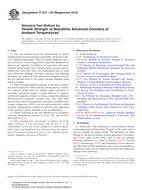Potrebujeme váš súhlas na využitie jednotlivých dát, aby sa vám okrem iného mohli ukazovať informácie týkajúce sa vašich záujmov. Súhlas udelíte kliknutím na tlačidlo „OK“.
ASTM C1273-05(2010)
Standard Test Method for Tensile Strength of Monolithic Advanced Ceramics at Ambient Temperatures
Automaticky preložený názov:
Štandardná skúšobná metóda pre pevnosť jednoliatej pokročilých keramiky pri izbovej teplote
NORMA vydaná dňa 1.6.2010
Informácie o norme:
Označenie normy: ASTM C1273-05(2010)
Poznámka: NEPLATNÁ
Dátum vydania normy: 1.6.2010
Kód tovaru: NS-10403
Počet strán: 18
Približná hmotnosť: 54 g (0.12 libier)
Krajina: Americká technická norma
Kategória: Technické normy ASTM
Anotácia textu normy ASTM C1273-05(2010) :
Keywords:
advanced ceramic, percent bending, tensile strength, tensile testing, Tensile properties/testing--ceramics, Uniaxial loading, Strain testing, Advanced ceramics, Loading tests--ceramics, Monolithic advanced ceramics, Percent bending, Quality assurance (QA), ICS Number Code 81.060.99 (Other standards related to ceramics), 81.060.30 (Advanced ceramics)
Doplňujúce informácie
| Significance and Use | ||||||||||||||||||||||
|
This test method may be used for material development, material comparison, quality assurance, characterization, and design data generation. High strength, monolithic advanced ceramic materials generally characterized by small grain sizes (<50 μm) and bulk densities near the theoretical density are candidates for load-bearing structural applications requiring high degrees of wear and corrosion resistance, and high temperature strength. Although flexural test methods are commonly used to evaluate strength of advanced ceramics, the non-uniform stress distribution of the flexure test specimen limits the volume of material subjected to the maximum applied stress at fracture. Uniaxially-loaded tensile strength tests provide information on strength-limiting flaws from a greater volume of uniformly stressed material. Although the volume or surface area of material subjected to a uniform tensile stress for a single uniaxially-loaded tensile test may be several times that of a single flexure test specimen, the need to test a statistically significant number of tensile test specimens is not obviated. Therefore, because of the probabilistic strength distributions of brittle materials such as advanced ceramics, a sufficient number of test specimens at each testing condition is required for statistical analysis and eventual design, with guidelines for sufficient numbers provided in this test method. Note that size-scaling effects as discussed in Practice C1239 will affect the strength values. Therefore, strengths obtained using different recommended tensile test specimens with different volumes or surface areas of material in the gage sections will be different due to these size differences. Resulting strength values can be scaled to an effective volume or surface area of unity as discussed in Practice C1239. Tensile tests provide information on the strength and deformation of materials under uniaxial tensile stresses. Uniform stress states are required to effectively evaluate any non-linear stress-strain behavior which may develop as the result of testing mode, testing rate, processing or alloying effects, or environmental influences. These effects may be consequences of stress corrosion or subcritical (slow) crack growth which can be minimized by testing at appropriately rapid rates as outlined in this test method. The results of tensile tests of test specimens fabricated to standardized dimensions from a particular material or selected portions, or both, of a part may not totally represent the strength and deformation properties of the entire, full-size end product or its in-service behavior in different environments. For quality control purposes, results derived from standardized tensile test specimens can be considered to be indicative of the response of the material from which they were taken for given primary processing conditions and post-processing heat treatments. The tensile strength of a ceramic material is dependent on both its inherent resistance to fracture and the presence of flaws. Analysis of fracture surfaces and fractography, though beyond the scope of this test method, is highly recommended for all purposes, especially for design data. |
||||||||||||||||||||||
| 1. Scope | ||||||||||||||||||||||
|
1.1 This test method covers the determination of tensile strength under uniaxial loading of monolithic advanced ceramics at ambient temperatures. This test method addresses, but is not restricted to, various suggested test specimen geometries as listed in the appendix. In addition, test specimen fabrication methods, testing modes (force, displacement, or strain control), testing rates (force rate, stress rate, displacement rate, or strain rate), allowable bending, and data collection and reporting procedures are addressed. Note that tensile strength as used in this test method refers to the tensile strength obtained under uniaxial loading. 1.2 This test method applies primarily to advanced ceramics that macroscopically exhibit isotropic, homogeneous, continuous behavior. While this test method applies primarily to monolithic advanced ceramics, certain whisker- or particle-reinforced composite ceramics as well as certain discontinuous fiber-reinforced composite ceramics may also meet these macroscopic behavior assumptions. Generally, continuous fiber ceramic composites (CFCCs) do not macroscopically exhibit isotropic, homogeneous, continuous behavior and application of this practice to these materials is not recommended. 1.3 Values expressed in this test method are in accordance with the International System of Units (SI) and . 1.4 This standard does not purport to address all of the safety concerns, if any, associated with its use. It is the responsibility of the user of this standard to establish appropriate safety and health practices and determine the applicability of regulatory limitations prior to use. Specific precautionary statements are given in Section 7. |
||||||||||||||||||||||
| 2. Referenced Documents | ||||||||||||||||||||||
|
Odporúčame:
Aktualizácia zákonov
Chcete mať istotu o platnosti využívaných predpisov?
Ponúkame Vám riešenie, aby ste mohli používať stále platné (aktuálne) legislatívne predpisy
Chcete vedieť viac informácií ? Pozrite sa na túto stránku.




 Cookies
Cookies
